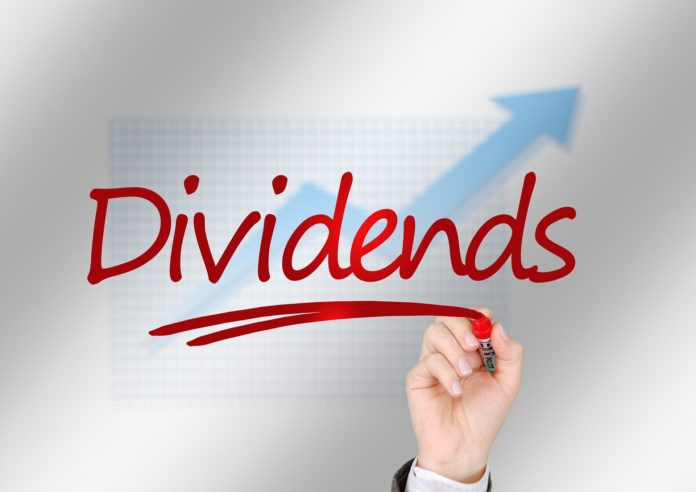We all know that money doesn’t grow on trees, but dividend stocks might be the next best thing.
When you invest in dividend stocks, you get paid in perpetuity (forever) for that single investment as long as you own the asset, and the company continues to pay dividends.
Sound too good to be true?
You might be surprised at the opportunities available to those who learn how to invest in dividend stocks.
This guide will tell you everything you need to know to get started investing in dividend stocks.
How to Invest in Dividend-Paying stocks
When it comes to investing, the general rule for any asset class is “buy low, sell high.” The strategy for investing in dividend-paying stocks, however, is slightly different.
Instead of looking for the next Amazon or Microsoft or trying to ride a stock on a wave of good news, the trick is to purchase shares in large, stable companies with a history of paying dividends. It’s even better if you can find companies that have steadily increased their payouts over a span of several years.
We’ll give you the step-by-step instructions on how to find opportunities and then begin purchasing your stock.
Look for Quality, Stable Companies
As a general rule, companies that pay dividends are stable, with a long track record of success. However, that’s not always the case, so you still have to do your research. You probably have an idea forming in your head already. Brands that are household names or products you use every day are most likely publicly traded companies with a history of paying dividends.
In fact, more large companies than not do pay dividends. Currently, 84% of the companies in the S&P 500 index pay dividends.
To give you some guidance on how to make your selections, we turn to Warren Buffett, arguably the most successful investor of all-time. Instead of following trends and media frenzy, Buffett takes a holistic approach in his analysis, aiming to understand what drives a company’s earnings and how viable they are as a business.
He also believes in investing for the long-term, famously saying, “If you aren’t willing to own a stock for 10 years, don’t even think about owning it for 10 minutes.”
To give you a more specific framework, here’s a glimpse of Buffett’s methodology to company analysis:
Company Performance
There are many stats to look at when evaluating company performance, but a shareholder’s return on investment is one of the most telling. In the stock trading world, this figure is represented as ROE (return on equity). It’s calculated by dividing net income by shareholder’s equity.
Return on Equity = Net Income / Average Shareholders’ Equity
You can find these figures on the company’s balance sheet.
Debt
Debt isn’t necessarily a bad thing. Companies often use it as a lever to grow. However, if you’re looking for stocks that are going to pay the highest dividends, you’ll want to know what a company’s debt-to-equity (D/E) ratio is. If it’s on the high end, the company will have to divert profits to serving that debt instead of paying dividends.
Debt-to-Equity Ratio = Total Liabilities / Shareholders’ Equity
Profit Margins
Profits are vital for any business to operate in the long-term, and in order to pay dividends, a company must be profitable. The key to look for is a steady or increasing profit margin. When you see that, dividend payments are likely to continue and even rise. However, a decreasing profit margin can put future dividend payments in jeopardy.
Age
Making a data-driven investment decision means you have to have plenty of data. Buffett suggests putting your money into companies that have been public for at least 10 years.
Reliance on Commodities
No one operates in a bubble, but being reliant on commodities with uncertain supply can put a company’s profits at risk. Specifically, companies that are reliant on oil and gas for their operations are vulnerable when the price of that commodity rises.
Price
And finally, the price of a company’s stock is also a vital consideration. How do you know if a stock is priced correctly, it’s overvalued or undervalued? It starts by determining the intrinsic value of the company. And that’s where the magic happens. Keep reading; we’re covering that next!
Take Advantage of DRIP Investing
When the company you own stock in pays dividends, you have two choices – collect a check or reinvest the dividends in the same company’s stock. A DRIP, short for dividend reinvesting plan, has several benefits:
- You take advantage of compound interest. If you’re a long-term investor, then you’ll see your investment in a stock multiply by reinvesting the dividends instead of cashing out. You won’t get rich overnight, but if you park your money in a dividend stock for 10+ years and continue to reinvest the dividends, you’ll start to see the compounding benefits.
- Reinvesting your dividends is fee and commission-free.
- DRIP gives you fractional shares. Instead of waiting until you have the money to purchase a full stock share, dividend reinvesting allows you to get portions of the stock and continue to build ownership.
Why Invest in Dividend Stocks?
Dividend stocks get a bad rap for being dull and low moneymakers. If you choose your dividend stocks wisely, nothing could be further from the truth!
They’re also known as being an ideal investment vehicle for older people, and while that’s true, younger generations are also beginning to see the value of generating steady income in an asset that also appreciates.
We’ve outlined the four main benefits of dividend stocks that demonstrate why they’re a smart buy for investors.
- Dividend stocks are the ultimate form of passive income. You get paid regularly just for owning a stock. Once you do the heavy lifting of making the trade, your work is over. You can sit back, relax, and drink piña coladas on the beach.
- Unlike day traders and penny stock evangelists, investors that choose dividend stocks don’t have to watch the market like a hawk. They can check their shares once or twice a day (or week) to ensure that the company hasn’t been liquidated or sued. Then they can relax knowing that they invested in a business that’s in it for the long haul. There are no sketchy startups or fly by night operations in the realm of dividend stocks.
- With dividend stocks, you get to take advantage of compound interest by utilizing a DRIP (dividend reinvestment plan). On autopilot, your money will grow over time.
- Dividend stocks offer a reliable stream of income. This benefit is particularly relevant for retirees looking for cashflow during their golden years.
Do You Pay Taxes on Dividends?
The short answer is yes. Dividends are taxable. Even if you reinvest them in a DRIP, they’re still subject to being taxed.
The amount you pay will vary based on the following:
- Your income – “Ordinary” dividends are taxed at your federal regular income tax rate. This range is from 10% to 37%.
- The type of dividend – There are two types of dividends: ordinary and qualified. While ordinary dividends are taxed at your regular bracket, qualified dividends are taxed as capital gains. The capital gains tax rate is lower – between 15% and 20%. There is one caveat here – if your income for the previous tax year was less than $38,600 (based on information from 2020), then you don’t pay any taxes on qualified dividends.
You’re probably wondering, “what’s an ordinary dividend and what’s a qualified dividend, and how do I know which ones I have?” Your brokerage account will specify which type of dividend you have, and that will guide you when you file taxes. In general, dividends become qualified when you’ve held a stock for a minimum amount of time (it varies), and there haven’t been any puts, calls, or short sales on the stock that you own.
Examples of Dividend Stocks
Most large companies pay dividends, though you’ll want to evaluate companies individually before assuming that you’ll receive a quarterly payout. In light of the pandemic, many companies suspended payments, including General Motors, Dunkin Donuts, AMC Entertainment, Vail Resorts, and dozens of others.
For the companies that still pay dividends, many have cut them drastically, but are still committed to paying what they can.
Here are some dividend stocks you can currently count on:
- Sherwin Williams: With many people stuck at home, DIY and home improvement projects are at a peak.
- Cintas: Despite skyrocketing unemployment, this uniform maker is still paying dividends. Profits could be coming from an increased turnover of clothing and hygiene concerns.
- McCormick & Co.: This spice company is enjoying a resurgence in demand from home cooking.
- Abbott Laboratories: Health and medical device companies continue to be a strong bet.
- Lowes: This hardware store chain is a steady dividend payer. Though they didn’t increase dividends in 2020, they’re still holding strong.
- Walmart: Dividend payouts from the third largest retailer are modest, but they’re blessedly steady.
Key Metrics to Look For
Once you have some experience under your belt, you’ll be reading financial statements and stock charts like a pro. But until then, we’ll give you some telltale metrics to evaluate before making an investment decision.
We talked earlier about some of the metrics to look at when value investing, and there are some additional numbers to look at when you’re looking specifically at dividend stocks:
- Dividend History: A long history of paying dividends not only bodes well for a stock, but it’s a good indicator that you’ll get paid dividends as a current and future investor. Look specifically at trends in the payouts. Are dividend disbursements going up or down?
- P/E Ratio: A high P/E ratio means that the stock is high-priced compared to its earnings. High P/E ratios aren’t necessarily good for dividend investors because it signals that the profits aren’t high relative to its stock price. In general, a lower ratio is best, but take a look at the company as a whole to confirm that the low P/E ratio isn’t due to investor skepticism.
- Dividend Yield: Dividend yield is the percentage of the share price that the company pays out in earnings. For example, if the share price is $100 and the annual dividend payout is $4, then the dividend yield is 4%. In most cases, the higher the yield, the better, but there are some caveats to consider.
Most notably, if the price of the stock drops, then the dividend yield seems higher. A $4 payout on a stock price of $80 has a higher return than if the price was $100. Though the yield is higher, the company could be in trouble.
- Payout Ratio: The payout ratio is the percentage of earnings paid out in dividends. It’s calculated by taking the yearly dividend per share and dividing it by the earnings per share. So, if the dividend was $2 and the EPS was $4, then the payout ratio is 50%.
As a rule of thumb, payout ratios between 35% and 55% are considered ideal. It shows that the company is still investing in the business but sharing a generous portion of the profits with its shareholders.
The Bottom Line
Though investing in dividend stocks is a potentially lucrative investment strategy, please keep in mind that there’s no guarantee that you’ll make a positive return.
The stock could drop more than what you get paid in dividends. The company could go out of business. Or, the company could stop slash dividends or stop paying them altogether (GE is one of the more notable companies to do this).








